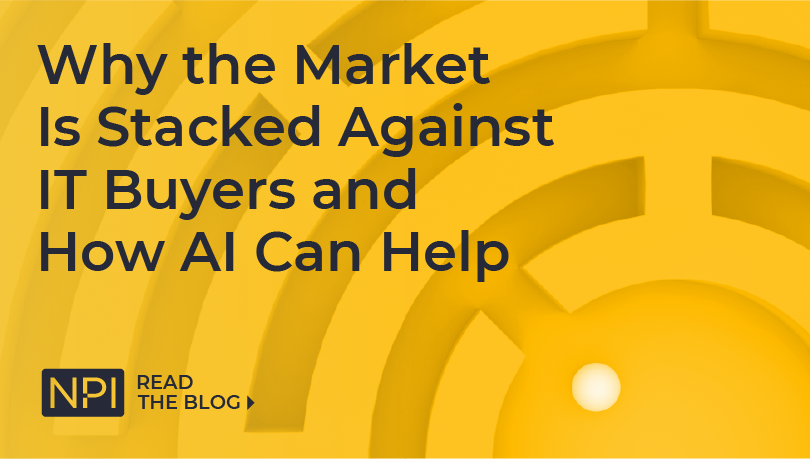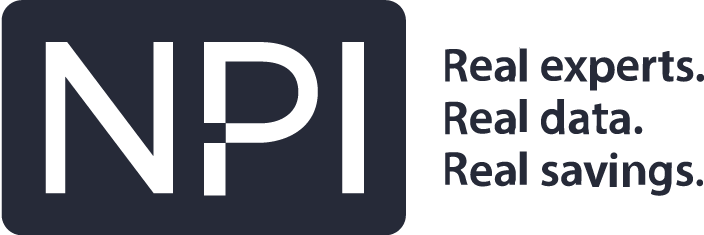BLOG
Why the Market is Stacked Against IT Buyers and How AI Can Help
A common refrain at NPI is that enterprise IT procurement practitioners have one of the toughest jobs in corporate America. Today’s IT sourcing pros are responsible for aligning business strategy, technical requirements, budget, vendor selection, and negotiation among very different groups of stakeholders – each of whom have their own agenda and expectations.
Meanwhile, despite their outsized responsibilities, most IT procurement teams are under-resourced and under-supported. They’re grappling with an accelerated pace of IT buying as transaction volume and spending grow. Gartner estimates worldwide IT spending will total $5.26 trillion in 2024. By 2030, that number will surpass $8 trillion.
We recently hosted a live session with SIG to discuss the state of IT procurement (and how AI can help). You can watch the full recording here. Here are some highlights of what we covered:
Why IT Vendors Hold More Leverage Over Enterprise IT Buyers
Buy-side leverage continues to erode for multiple reasons. The internal dynamics mentioned earlier play a large role in this, but it’s the external dynamics that present the biggest challenges:
- Rampant Pricing Disparity – There is no Kelley Blue Book for IT buying. Each purchase has dozens of unique factors that impact pricing and terms. Determining whether or not you’re getting a good deal from a vendor is impossible without access to external peer purchasing data. This is why vendors can get away with 10 to 90% variance in pricing for similar purchases.
- Overly Complex Licensing – The number of licensing/subscription options offered by enterprise tech vendors is astounding. Microsoft has well over 1,000 SKUs, not including Azure. Salesforce estates can comprise 25+ products. Usage terms and definitions vary vendor to vendor. Exacerbating the problem is licensing models and terms change constantly. The knowledge you gained from your last Microsoft EA or SAP renewal could be null and void at your next renewal.All of this points to a larger problem – overbuying. Vendors intentionally make licensing complex so it’s easier for customers to buy more quantities or functionality than they need.
- Clear Vendor Advantages – It’s important to acknowledge the sophistication of the enterprise tech vendor sales machine. They are the most highly-trained, highly-compensated sales teams in the world. They execute strategic selling playbooks that are designed to extract the maximum revenue possible from every transaction.Incumbent vendors are typically deeply entrenched in customer’s IT and operational infrastructures. This makes is difficult for customers to switch to a provider, giving vendors excessive leverage during negotiations.
- Avalanche of IT Renewals – Managing the status quo has become overwhelming as IT buyers must manage, prepare and negotiate an inordinate number of renewals. For this reason, many teams take an “autopilot” approach to renewals, simply agreeing to “routine” cost and quantity increases without reconciling actual usage requirements with scope.
Using AI to Gain Leverage and Improve IT Procurement Outcomes
In today’s fast-paced IT procurement landscape, AI has become a valuable tool to help tech sourcing pros overcome the vendor/buyer leverage imbalance. It has the potential to transform the way organizations approach IT purchasing, enabling them to make smarter, more strategic decisions (for NPI Vantage Pro™ clients, it already is!).
The harnessing of AI-driven insights in certain high-impact areas of the IT vendor negotiation process gives IT procurement leaders a significant edge. These areas include:
- Competitor Intelligence: AI-driven tools can significantly enhance competitor intelligence in IT procurement by providing real-time insights into the market landscape. By analyzing competitors’ pricing strategies, product offerings, and market positions, AI helps procurement leaders understand where their organization stands and identify opportunities for leverage. These insights allow procurement teams to negotiate better terms, as they can anticipate competitors’ moves and counter with more informed strategies. This level of intelligence enables organizations to make data-driven decisions that improve purchasing outcomes and maintain a competitive edge.
- Price Trend Tracking: Tracking price trends is crucial for IT procurement and, with access to extensive peer purchase data, AI can make a huge difference here. AI-powered analytics can detect patterns in pricing, helping procurement teams anticipate market shifts and price fluctuations. By understanding these trends, organizations can time their more purchases strategically and secure optimal pricing.
- Supplier Risk: AI enhances the assessment of supplier risk by analyzing multiple factors such as supply chain stability, cybersecurity practices, and compliance with ESG standards. AI algorithms can quickly evaluate these risks and provide a comprehensive overview of a supplier’s reliability. This allows procurement teams to make informed decisions, avoiding potential pitfalls associated with high-risk suppliers. By reducing supplier-related uncertainties, AI helps ensure that IT procurement processes are more secure and resilient, minimizing the likelihood of disruptions.
- Deal Prioritization and Categorization: AI can revolutionize deal prioritization and categorization by automating the analysis of various deal parameters, such as expiration dates, contract values, and negotiation complexity. AI tools can rank deals based on their importance and urgency, enabling procurement leaders to focus on the most critical negotiations first. This strategic approach ensures that resources are allocated efficiently, and high-value deals are not overlooked. Additionally, AI can categorize deals into different risk and value segments, allowing for a more tailored negotiation strategy.
- Market Behavior Scoring: AI-powered market behavior scoring provides procurement leaders with an in-depth understanding of market dynamics. By analyzing factors like vendor pricing variability, market demand, and economic indicators, AI assigns scores that reflect the current market behavior. These scores help procurement teams align their strategies with market conditions, ensuring they are negotiating and purchasing at optimal times. With accurate market behavior scores, organizations can make more informed decisions that lead to better purchasing outcomes, ultimately enhancing the value obtained from IT investments.
Empowering IT Procurement with AI
The complexities and challenges of IT procurement are undeniable, particularly as the market dynamics continue to shift in favor of vendors. However, AI offers a powerful counterbalance, enabling procurement leaders to regain leverage and make smarter, data-driven decisions. It not only streamlines decision-making but also drives more favorable outcomes, ensuring organizations are protected against overspending in an increasingly competitive market.
For those who want to dive deeper into these topics, don’t forget to check out this recording of our recent SIG educational session!
Interested in learning more about AI-enabled IT procurement? Discover how NPI Vantage Pro can streamline enterprise IT buying or contact us directly.


